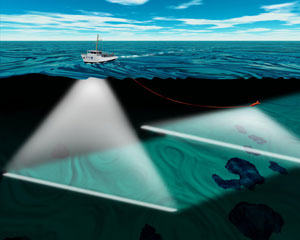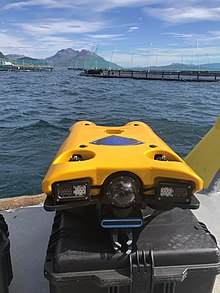
Underwater archaeology is archaeology practiced underwater. As with all other branches of archaeology, it evolved from its roots in pre-history and in the classical era to include sites from the historical and industrial eras. Its acceptance has been a relatively late development due to the difficulties of accessing and working underwater sites, and because the application of archaeology to underwater sites initially emerged from the skills and tools developed by shipwreck salvagers. As a result, underwater archaeology initially struggled to establish itself as actual archaeological research. This changed when universities began teaching the subject and a theoretical and practical base for the sub-discipline was firmly established in the late 1980s. Underwater archaeology now has a number of branches including, maritime archaeology: the scientifically based study of past human life, behaviours and cultures and their activities in, on, around and (lately) under the sea, estuaries and rivers. This is most often effected using the physical remains found in, around or under salt or fresh water or buried beneath water-logged sediment. In recent years, the study of submerged WWII sites and of submerged aircraft in the form of underwater aviation archaeology have also emerged as bona fide activity.

A remotely operated vehicle (ROV) is a free-swimming submersible craft used to perform tasks such as valve operations, hydraulic functions and other general tasks within the subsea oil and gas industry. ROVs can also carry tooling packages for undertaking specific tasks such as pull-in and connection of flexible flowlines and umbilicals, and component replacement.
Underwater divers may be employed in any branch of an armed force, including the navy, army, marines, air force and coast guard. Scope of operations includes: search and recovery, search and rescue, hydrographic survey, explosive ordnance disposal, demolition, underwater engineering, salvage, ships husbandry, reconnaissance, infiltration, sabotage, counterifiltration, underwater combat and security.

A submersible is an underwater vehicle which needs to be transported and supported by a larger watercraft or platform. This distinguishes submersibles from submarines, which are self-supporting and capable of prolonged independent operation at sea.

Kaikō was a remotely operated underwater vehicle (ROV) built by the Japan Agency for Marine-Earth Science and Technology (JAMSTEC) for exploration of the deep sea. Kaikō was the second of only five vessels ever to reach the bottom of the Challenger Deep, as of 2019. Between 1995 and 2003, this 10.6 ton unmanned submersible conducted more than 250 dives, collecting 350 biological species, some of which could prove to be useful in medical and industrial applications. On 29 May 2003, Kaikō was lost at sea off the coast of Shikoku Island during Typhoon Chan-Hom, when a secondary cable connecting it to its launcher at the ocean surface broke.

The Scorpio is a brand of underwater submersible Remotely Operated Vehicle (ROV) manufactured by Perry Tritech used by sub-sea industries such as the oil industry for general operations, and by the Royal Navy and the United States Navy for submarine rescue services. Originally developed by AMETEK Straza of El Cajon, United States, they were subsequently developed by Perry Tritech. Although the design of the original Scorpio is over several decades old, it forms the basis for a current generation of Scorpio-branded ROVs. Scorpio ROVs are named in a sequence following the order of manufacture, such as "Scorpio 17" or "Scorpio 45" which refer to specific ROVs.

The Monterey Bay Aquarium Research Institute (MBARI) is a private, non-profit oceanographic research center in Moss Landing, California. MBARI was founded in 1987 by David Packard, and is primarily funded by the David and Lucile Packard Foundation. Christopher Scholin serves as the institute's president and chief executive officer, managing a work force of approximately 220 scientists, engineers, and operations and administrative staff.
Underwater Port Security System (UPSS) was developed for the United States Coast Guard and the Maritime Safety and Security Teams (MSSTs) for defense against swimmer incursions. It includes the Underwater Inspection System (UIS) and the Integrated Anti-Swimmer System (IAS). Recent developments in terrorism have highlighted the need for underwater anti-frogman security. The UPSS is made in the United States and is reported to be compact enough fit in a large suitcase.

Unmanned underwater vehicles (UUV), sometimes known as underwater drones, are submersible vehicles that can operate underwater without a human occupant. These vehicles may be divided into two categories: remotely operated underwater vehicles (ROUVs) and autonomous underwater vehicles (AUVs). ROUVs are remotely controlled by a human operator. AUVs are automated and operate independently of direct human input.

Jason is a two-body remotely operated vehicle (ROV) designed, built, and operated by the National Deep Submergence Laboratory of the Woods Hole Oceanographic Institution (WHOI). Construction of Jason began in 1982 and was first launched in 1988, redesigned in 2002 as the second iteration of the ROV. The ROV allows scientists and explorers to have access to the seafloor without leaving the deck of a ship.
Jason Junior, also called JJ, was a small remotely operated vehicle (ROV) designed and built by the Deep Submergence Laboratory at the Woods Hole Oceanographic Institute (WHOI). Jason Jr. was a prototype for a larger, more capable ROV named Jason, which was being developed to complement the Argo unmanned undersea video camera sled.
Oceaneering International, Inc. is a subsea engineering and applied technology company based in Houston, Texas, U.S. that provides engineered services and hardware to customers who operate in marine, space, and other environments.
Sea Dragon-class remotely operated underwater vehicles (ROUVs) are a class of Chinese remotely operated vehicle (ROV) used to perform various underwater tasks such as oil platform service, salvage, and rescue missions. Following the successful development of the original Sea Dragon (海龙), a series of ROUVs based on it have been developed. The original model had a diving capability up to 3,500 meters, but subsequent models were designed to meet a variety of operating conditions.
SJT-class ROUVs are a series of Chinese remotely operated underwater vehicles (ROUVs) jointly developed by the Shenyang Institute of Automation of the Chinese Academy of Science and the Institute of Underwater Engineering of Shanghai Jiao Tong University (SHJTU). The general designer of the SJT-class of ROUVs is Zhu Jimao (朱继懋), a professor at SHJTU, who also was the general designer of the earlier Type 7103 DSRV. Many more ROUVs have been developed after the SJT series, based on experience gained from this series.
ABISMO is a remotely operated underwater vehicle (ROV) built by the Japan Agency for Marine-Earth Science and Technology (JAMSTEC) for exploration of the deep sea. It is the only remaining ROV rated to 11,000-meters, ABISMO is intended to be the permanent replacement for Kaikō, a ROV that was lost at sea in 2003.

SeaTrepid International, LLC is an underwater engineering and service company located in Robert, Louisiana, providing underwater robotic solutions for the Oil and Gas industry, and other underwater industries.
Underwater work is work done underwater, generally by divers during diving operations, but includes work done underwater by remotely operated vehicles and crewed submersibles.
Diving support equipment is the equipment used to facilitate a diving operation. It is either not taken into the water during the dive, such as the gas panel and compressor, or is not integral to the actual diving, being there to make the dive easier or safer, such as a surface decompression chamber. Some equipment, like a diving stage, is not easily categorised as diving or support equipment, and may be considered as either.

An underwater survey is a survey performed in an underwater environment or conducted remotely on an underwater object or region. Survey can have several meanings. The word originates in Medieval Latin with meanings of looking over and detailed study of a subject. One meaning is the accurate measurement of a geographical region, usually with the intention of plotting the positions of features as a scale map of the region. This meaning is often used in scientific contexts, and also in civil engineering and mineral extraction. Another meaning, often used in a civil, structural, or marine engineering context, is the inspection of a structure or vessel to compare actual condition with the specified nominal condition, usually with the purpose of reporting on the actual condition and compliance with, or deviations from, the nominal condition, for quality control, damage assessment, valuation, insurance, maintenance, and similar purposes. In other contexts it can mean inspection of a region to establish presence and distribution of specified content, such as living organisms, either to establish a baseline, or to compare with a baseline.

Underwater exploration is the exploration of any underwater environment, either by direct observation by the explorer, or by remote observation and measurement under the direction of the investigators. Systematic, targeted exploration is the most effective method to increase understanding of the ocean and other underwater regions, so they can be effectively managed, conserved, regulated, and their resources discovered, accessed, and used. Less than 10% of the ocean has been mapped in any detail, less has been visually observed, and the total diversity of life and distribution of populations is similarly obscure.












